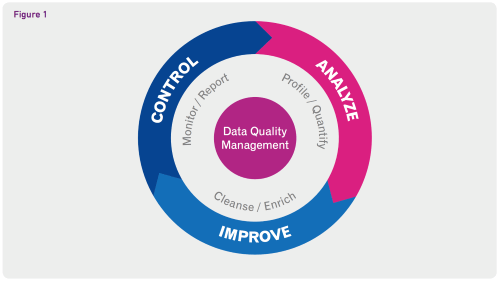Data is truly at the heart of every organization. We use it to back up business proposals and initiatives, prepare forecasts and projections, pinpoint areas for improvement, and substantiate cases we try to build. We can’t rely solely on instinct and gut feeling because they are intangible, and with the amount of information collected in today’s data-driven society, most businesses have come to expect the credibility that data brings and are investing in that power.
Building a data management program is foundational to putting data at the forefront of your organization. But knowing what goes into a successful data management program is an iterative process that takes continuous improvement because it relies on people, processes, and technology.
But don’t worry; we’re here to help. We’ve broken down the components of a successful data management program into three straightforward steps: analyze, improve, and control. We will go into each step so that you’ll know exactly what to do to build a continuously successful program.

1. Analyze
This step involves assessing the current landscape of your data to see what needs to be done to improve it. Starting an initiative of this magnitude requires buy-in from the top—we’re talking C-suite. The CDO and CIO should be the main stakeholders, with the IT department overseeing the initial assessment of how your organization's data quality is faring.
Your data architects can help you plan a data management strategy based on what the assessment results show.
2. Improve
Once the analysis has been completed, next begins the actual implementation of the strategy that's been developed. This step involves constant and continual communication between the CDO/CIO, data architects, and IT department.
Everyone involved will need to help define the rules and processes surrounding the way data is used and collected in your organization. Things like data cleansing, standardization, and enrichment are defined in this step. Not having standardized data is often a common discovery in this phase. You'll discover many variations in the way people enter data. For example, names and places can be shortened and jargonized, all of which will hinder the analyses your business may be conducting.
That's why data cleansing and standardization are such important elements in a data management program. These actions provide the foundation for every subsequent action using that data. You won't truly know the potential impact of your data until you're able to trust it implicitly to make decisions.
3. Control
This step should be the easy part. Phew! Once you've transformed your data via cleansing or standardization or enrichment, you can use it to achieve your business objectives. Are you trying to run a loyalty program that needs email enrichment in order to target the right customers? Can you now use your deduplicated database to make accurate projections for how many new customers your businesses has attracted over the past year? The perks of good data are many, and they’re yours for the taking--you just need to make data management a priority first.
If you've defined data as an important organizational asset, congratulations! You've already started the process of building a better data management program. Use these three steps to help you on your way to constructing a scalable and lasting road to better data.
Are you on the path to better data management? We can help you get there.
Learn about our data management platform








